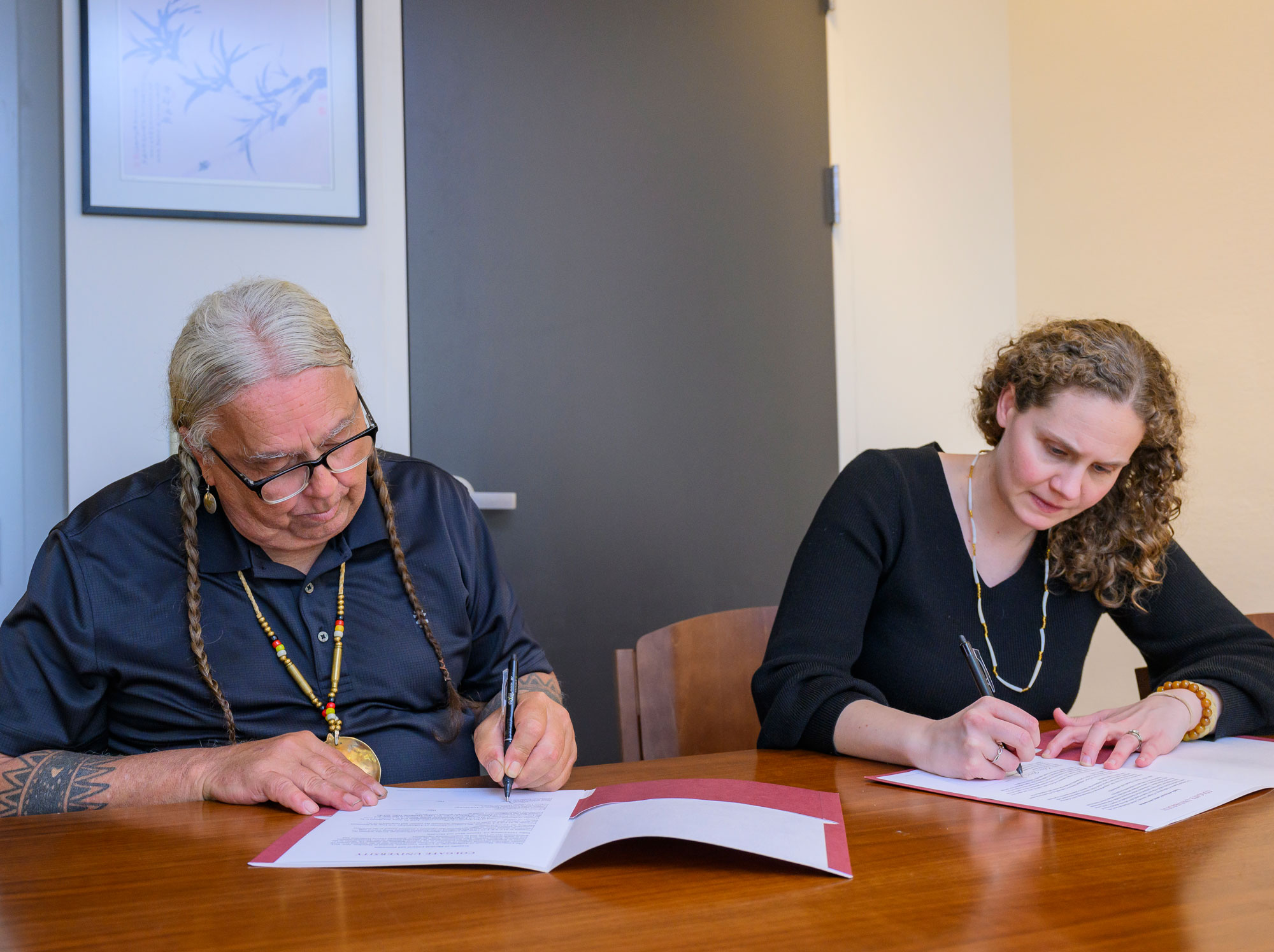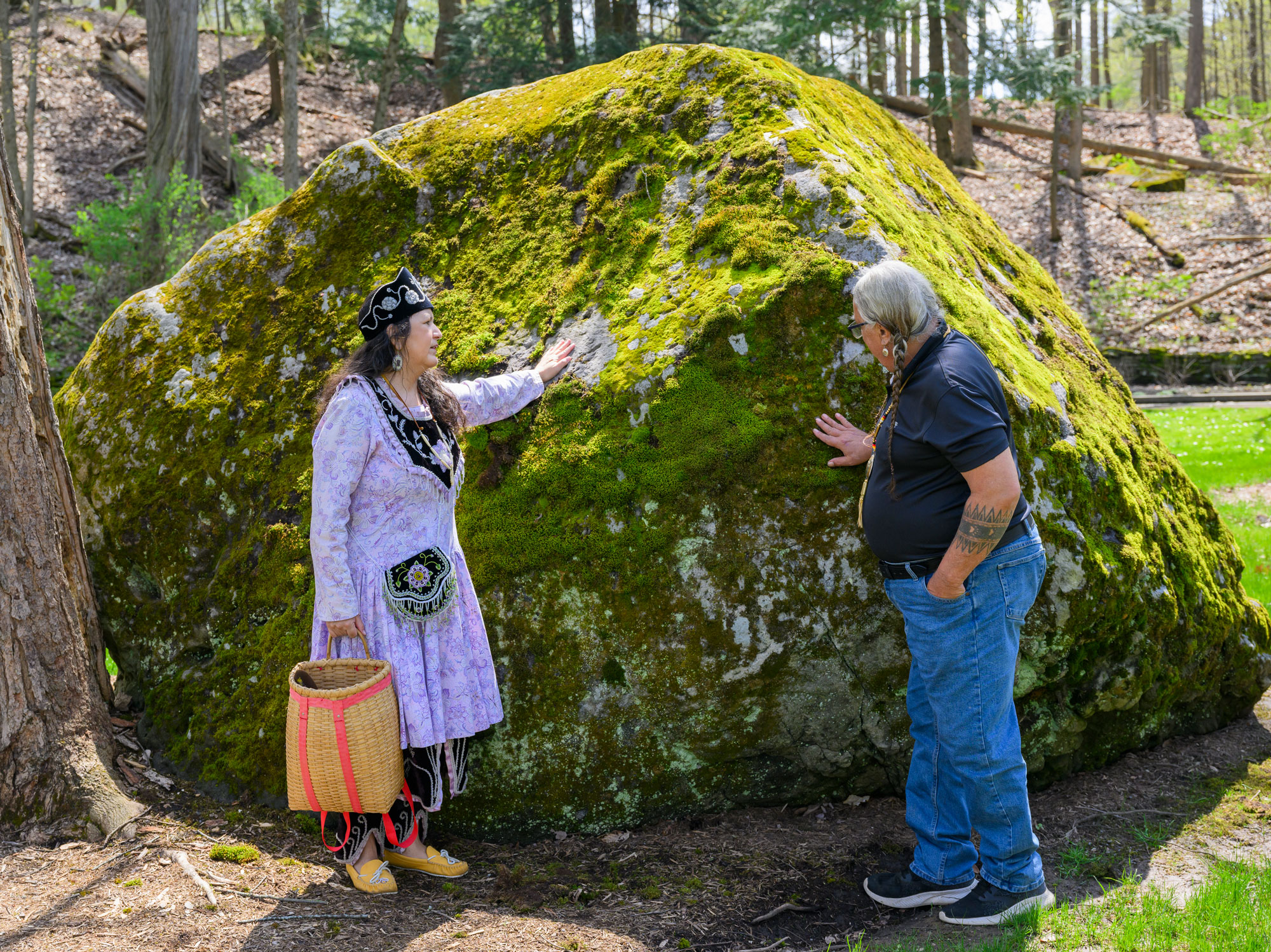Colgate University has officially marked the historic return of an Ancestor to the Piscataway Indian Nation in Maryland. This is the first such repatriation for Ancestral remains removed from what is now the state of Maryland through the federal Native American Graves Protection and Repatriation Act (NAGPRA). The Ancestor has been in the care of the Longyear Museum of Anthropology since 1948 and is the University’s longest-held Ancestor. The return follows years of collaboration between Chesapeake Bay–area Indigenous Nations and the University.
Piscataway Indian Nation Chief Mark Tayac; his wife, Evelyn (Dakota); and Peter Landeros, Pascua Yaqui Tribe member and regional president of the American Indian Movement, traveled to Hamilton, N.Y., for the ceremony, which was also attended by Provost and Dean of the Faculty Lesleigh Cushing.
During the ceremony, held at the end of the spring semester, Chief Tayac noted that his people were given original instructions by the Creator. “The last instruction is to return to Mother Earth,” Tayac said. “Today, we are helping this Ancestor fulfill that original instruction and to rest in peace. If your grandparents died, you would be sad, and you want them to rest in peace. That is what we want, too.”
Provost Cushing described the ceremony as “tremendously moving. It was an honor to have been invited to this momentous event, to meet and learn from Chief Tayac and his delegation, and to participate in the solemn ceremony of return,” she said. “I am grateful to work with colleagues in our museums at Colgate who pursue their work with such care, sensitivity, and thoughtfulness, and who are committed to redressing historical wrongs in our collections practices.”
The Ancestor was brought to the University — for inclusion in Colgate’s teaching collection — by sociology and anthropology professor Frederick Hulse, through a transfer from T.D. Stewart, curator of the physical anthropology department at the U.S. National Museum (now the Smithsonian National Museum of Natural History).
While NAGPRA requires the return of Ancestors to Bands, Nations, and Tribes recognized by the U.S. Government, this particular individual was identified as a member of the Piscataway peoples. The Piscataway Indian Nations and Choptico Band of Indians of the Piscataway-Conoy Tribe were recognized by the State of Maryland in 2012.
Colgate first reported knowledge of the Ancestor to National NAGPRA in 2004, but efforts to return them to their people began in earnest in 2021, more than seven decades after their arrival. Co-director of University Museums and Curator of the Longyear Museum of Anthropology Rebecca Mendelsohn and former Curatorial Assistant and NAGPRA Coordinator Kaytlynn Lynch sent initial letters inviting consultation with state and federally recognized Nations near St. Mary’s County, Md.
That year, Rico Newman, elder of the Choptico Band of Indians of the Piscataway-Conoy Tribe, responded with a proposal for the respectful disposition of the Ancestral remains in coordination with other Piscataway tribes.
Anticipating forward movement, Repatriation Manager Kelsey Olney-Wall, Community Liaison Lisa Latocha (Oneida Indian Nation), with the support of Curatorial Assistant Summer Frazier (Onondaga Nation), began the necessary research required to support a return, including historical site information, land claims, and inventories. That work, carried out in 2022, was rewarded in early 2023, when the team received replies from Chief Tayac and, subsequently, Tribal Administrator Reggie Tupponce of the federally recognized Upper Mattaponi Indian Tribe in Virginia. Administrator Tupponce supported the return under NAGPRA guidelines, while the Piscataway were represented by Tayac and Newman.
“As hard as this work is — when it seems impossible — it’s not. Even if you have little to no information, even if it seems like it’s not going to work, you have to keep going. You have to make sure that all Ancestors are returned home,” says Olney-Wall. “That’s where they should have been all along. We never should have had any Ancestors to begin with. To me, it’s a privilege to be able to work with these Nations, to not have their Ancestors be in boxes on shelves, to return them to their families, to return them to rest.”
Staff submitted their research and supporting documents to National NAGPRA in November of 2023, and an announcement was published in the Federal Register in January of 2024 to declare the Ancestor’s cultural affiliation and solicit comment. These official acts and consistent outreach to tribal representatives culminated in the April 30 ceremony — “a historic moment,” in the words of Chief Tayac.
Landeros underscored the importance of this return for everyone involved in the complex process. “When it comes to the burial of our Ancestors, that is their final resting place. That is where they remain so that they can walk with their Ancestors. To be removed brings them back to this world. They are stuck here, in this realm of human beings. Imagine being at rest for hundreds of years, then being ripped back. Our Ancestors have to go back into the ground — this allows them to rest. Our Ancestors are not your objects.”


